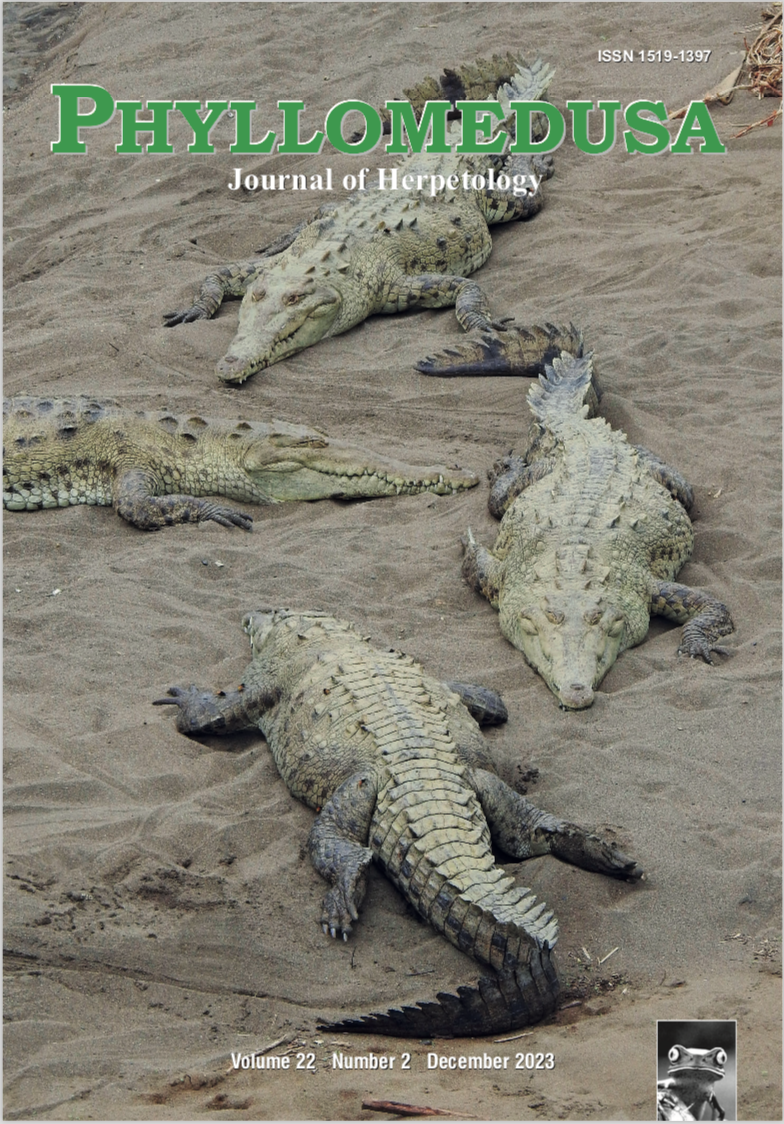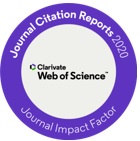O papel dos dentes modificados em mordidas prolongadas de Hierophis viridiflavus (Serpentes: Colubridae)
DOI:
https://doi.org/10.11606/issn.2316-9079.v22i2p121-130Palavras-chave:
Glândula de Duvernoy, Opistoglifodonte, Presas modificadas, SerpentesResumo
A análise dos ossos maxilares, palatinos, pterigóides e dentários de Hierophis viridiflavus carbonarius revelou a presença de sulcos e cristas nos dentes dos quatro ossos dentíferos. Dentes posteriores ampliados e modificados foram encontrados nos maxilares posteriores, separados por diástemas alveolares e alinhados de forma diferente dos dentes maxilares anteriores. Tanto nos espécimes vivos como nos dissecados, a glândula de Duvernoy, associada à produção de toxinas, circunda os dentes maxilares posteriores, que liberam as secreções produzidas pela glândula. Essas características, além da inflição de mordidas prolongadas, facilitam a dominação da presa. A morfologia do arco palatomaxilar coloca H. viridiflavus no grupo dos colubróides opistóglifos, cujas presas modificadas facilitam a inoculação de secreções, consideradas uma “forma primitiva de veneno”. Outras espécies de grandes colubróides simpátricos também foram examinadas, e algumas estruturas análogas foram observadas.
Downloads
Referências
Di Nicola, M. R., L. Cavigioli, L. Luiselli, and F. Andreone. 2021. Anfbi & Rettili d’Italia - Edizione Aggiornata. Latina. Edizioni Belvedere. 576 pp.
Dutto, M., I. Ineich, F. Serre-Collet, M. Goyfon, and R. Bédry. 2015. Trois cas de morsures du Colubridé Hierophis viridifavus (Lacépède, 1789). Bulletin de la Société Herpétologique de France 156: 55–62.
Filippi, E., M. Capula, and L. Luiselli. 2003. Dietary shifts in the Western Whip Snake Coluber viridifavus Lecépède, 1789 of the small Mediterranean island of Ustica (Squamata: Serpentes: Colubridae). Herpetozoa 16: 61–66.
Fry, B. G., H. Scheib, L. van Weerd, B. A. Young, J. McNaughtan, S. F. R. Ramjan, R. E. Poelmann, and J. A. Norman. 2008. Evolution of an arsenal: structural and functional diversifcation of the venom system in the advanced snakes. Molecular & Cellular Proteomics 2008: 215–246.
Gardner-Thorpe, C. 1967. Snakebite poisoning. British Medical Journal 26: 558.
Gläßer-Trobisch, A. and D. Trobisch. 2008. Bissunfall bei einer Ringelnatterfütterung. Elaphe 16: 59–61.
Jackson, K. 2003. The evolution of venom-delivery systems in snakes. Zoological Journal of the Linnean Society 137: 337-354.
Kardong, K. V. 1982. The evolution of the venom apparatus in snakes from colubrids to viperdis & elapids. Memórias do Institudo de Butantan 46: 105–118.
Kardong, K. V. and P. A. Lavin-Murcio. 1993. Venom delivery of snakes as high-pressure and low-pressure systems. Copeia 1993: 644–650.
Kazemi, S. M., M. H. Jahan-Mahin, T. Mohammadian-Kalat, M. S. Hosseinzadeh, and S. A. Weinstein. 2023. Local envenoming by the coinsnake or Asian racer, Hemorrhois nummifer and mountain racer or leopard snake, Hemorrhois ravergieri (Serpentes: Colubridae, Colubrinae) in Iran: a reminder of the importance of species identifcation in the medical management of snakebites. Toxicon 226: 107070.
Kreiner, G. 2007. The Snakes of Europe. Frankfurt am Main. Edition Chimaira. 317 pp.
Lumsden, N. G., B. G. Fry, R. Manjunatha Kini, and W. C. Hodgson. 2004. In vitro neuromuscular activity of ‘colubrid’ venoms: clinical and evolutionary implications. Toxicon 43: 819–827.
Malik, G. M. 1995. Snake bites in adults from the Asir region of southern Saudi Arabia. American Journal of Tropical Medicine and Hygiene 52: 314–317.
Mamonov, G. 1977. Case report of envenomation by the mountain racer, Coluber ravergieri in USSR. The Snake 9: 27–28.
Mondino, A., J. Crovadore, F. Lefort, and S. Ursenbacher. 2022. Impact of invading species on biodiversity: diet study of the green whip snake’s (Hierophis viridifavus, L. 1789) in Switzerland. Global Ecology and Conservation 38: e02239.
Nagy Z. T., R. Lawson, U. Joger, and M. Wink. 2004. Molecular systematics of racers, whipsnakes and relatives (Reptilia: Colubridae) using mitochondrial and nuclear markers. Journal of Zoological Systematics and Evolutionary Research 42:223–233.
Oliveira, L., R. R. Scartozzoni, S. M. Almeida-Santos, C. Jared, M. M. Antoniazzi, and M. G. Salomão. 2016. Morphology of Duvernoy’s glands and maxillary teeth and a possible function of the Duvernoy’s gland secretion in Helicops modestus Günther, 1861 (Serpentes: Xenodontinae). South American Journal of Herpetology 11: 54–65.
Ovadia, M., 1984. Embryonic development of Duvernoy’s gland in the snake, Natrix tessellata (Colubridae). Copeia 1984: 516–521.
Paterna, A. 2015. Morphological traits of hatchlings of the Western Whip snake Hierophis viridifavus (Lacépède, 1789) from a central Italian population. Russian Journal of Herpetology 22: 179–187.
Paterna, A. 2023. Intraspecifc oophagy in Hierophis viridifavus (Serpentes: Colubridae) during oviposition in a controlled environment. Phyllomedusa 22: 29–35.
Phisalix, M. 1922. Animaux Venimeux et Venins. Volume 2. Paris. Masson et Cie. 1512 pp.
Phisalix, M. and F. Caius. 1916. Propriétés venimeuses de la salive parotidienne chez des Colubridæ aglyphes des genres Tropidonotus Kuhl, Zamenis et Helicops Wagler. Bulletin du Muséum National d’Histoire Naturelle 22: 213–218.
Racca, L., A. Villa, L. C. M. Wencker, M. Camaiti, H. A. Blain, and M. Delfno M. 2020. Skull osteology and osteological phylogeny of the Western Whip snake Hierophis viridifavus (Squamata, Colubridae). Journal of Morphology 281: 808–836.
Ranayhossaini, D. J. 2010. An Investigation of the Hemotoxicity of the Duvernoy’s Gland Secretion of the Northern Water Snake (Nerodia sipedon). Pennsylvania State University Schreyer Honors College. 26 pp.
Rodriguez-Robles, J. A. 1994. Are the Duvernoy’s gland secretions of colubrid snakes venoms? Journal of Herpetology 28: 388–390.
Satora, L. 2004. Bites by the grass snake Natrix natrix. Veterinaryand Human Toxicology 46: 334–334.
Sindaco R., G. Doria, E. Razzetti, and F. Bernini. 2006.
Atlante degli Anfbi e dei Rettili d’Italia. Firenze. Societas Herpetologica Italica. Edizioni Polistampa. 792 pp.
Taub, A. M. 1967. Comparative histological studies on Duvernoy’s gland of colubrid snakes. Bulletin of the American Museum of Natural History 138: 1–50.
Weinstein, S. A, J. White, D. E. Keyler, and D. A. Warrell. 2013. Non front-fanged colubroid snakes: a current evidence based analysis of medical signifcance. Toxicon 69: 103–13.
Weinstein, S. A., D. A. Warrell, J. White, and D. E. Keyler. 2011. “Venomous” Bites from Non Venomous Snakes. A Critical Analysis of Risk and Management of “Colubrid” Snake Bites. Waltham. Elsevier Inc. 364 pp.
Weinstein, S. A. and K. V. Kardong. 1994. Properties of Duvernoy’s secretions from opisthoglyphous and aglyphous colubrid snakes. Toxicon 32: 1161–1185.
Young, B. A. and K. V. Kardong. 1996. Dentitional surface features in snakes (Reptilia: Serpentes). AmphibiaReptilia 17: 261–276.
Zalisko, E. J. and Kardong, K. V. 1992. Histology and histochemistry of the Duvernoy’s gland of the brown tree snake Boiga irreguluria” (Colubridae). Copeia 1992: 791–798.
Downloads
Publicado
Edição
Seção
Licença
Copyright (c) 2023 ESALQ-USP

Este trabalho está licenciado sob uma licença Creative Commons Attribution-NonCommercial-NoDerivatives 4.0 International License.
All material originally published in Phyllomedusa belongs to Escola Superior de Agricultura Luiz de Queiroz - Universidade de São Paulo. All contents are under a license of Creative Commons BY-NC-ND.


 Impact Factor: 0.383
Impact Factor: 0.383  CiteScore: 0.7
CiteScore: 0.7